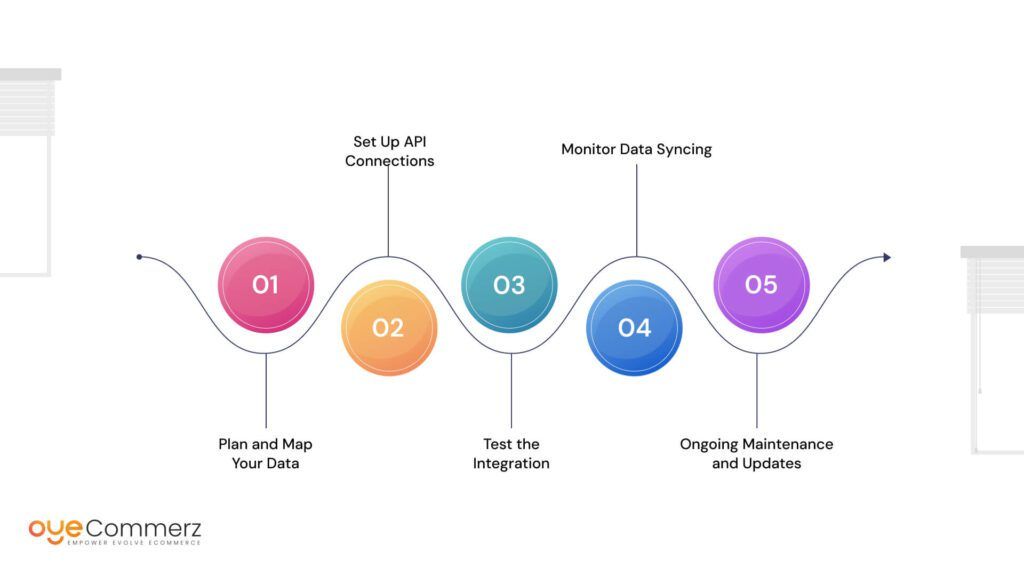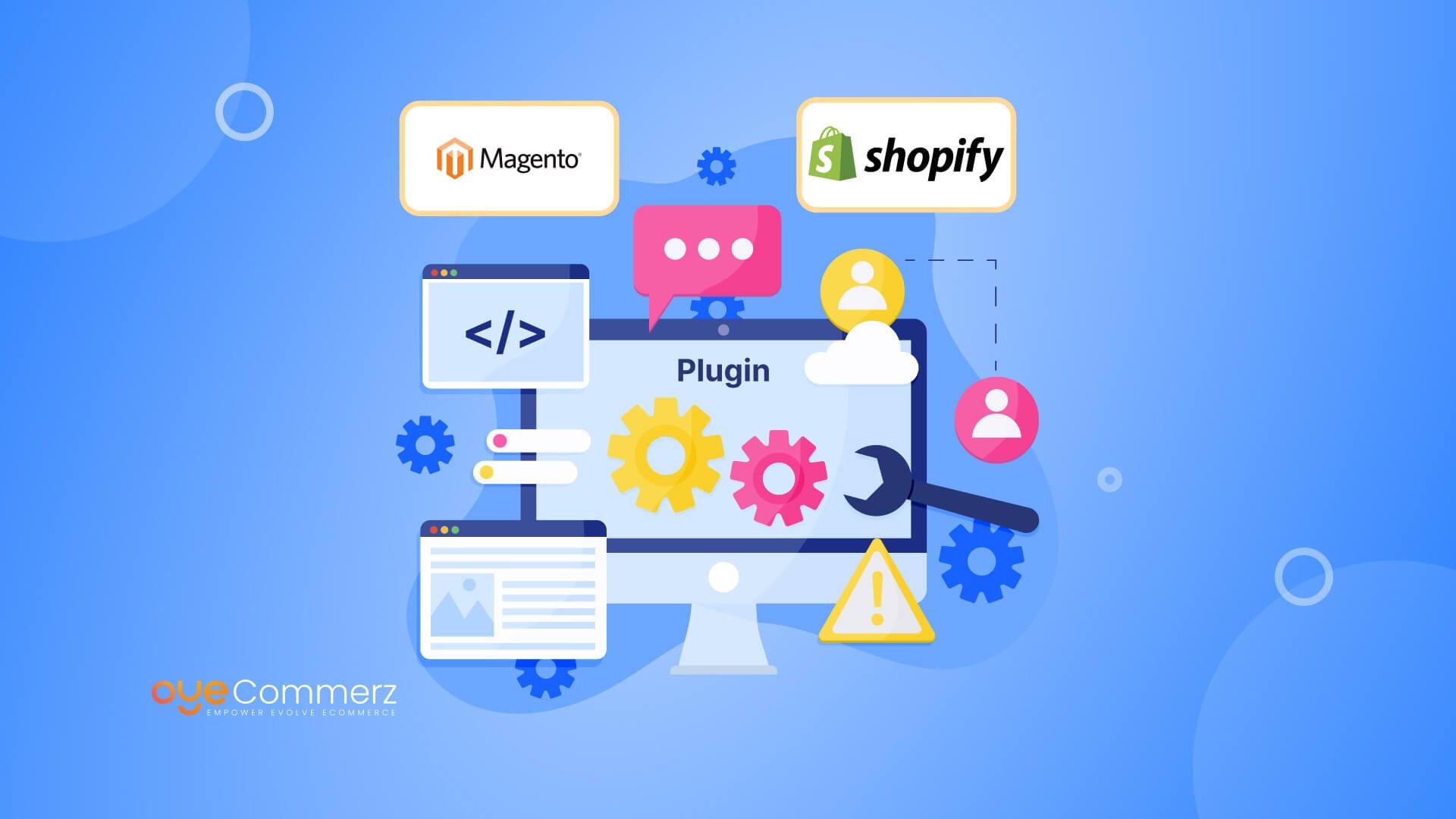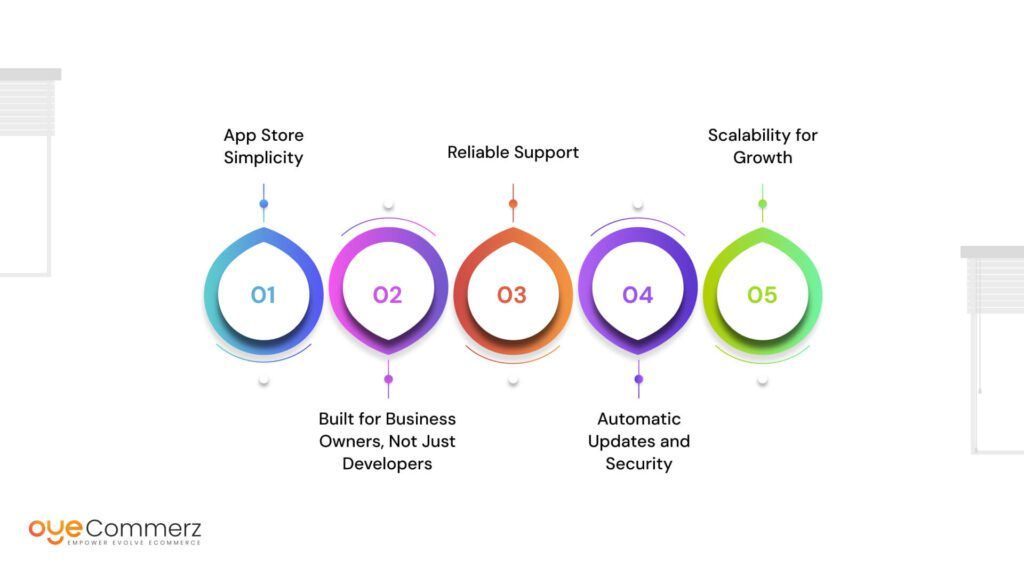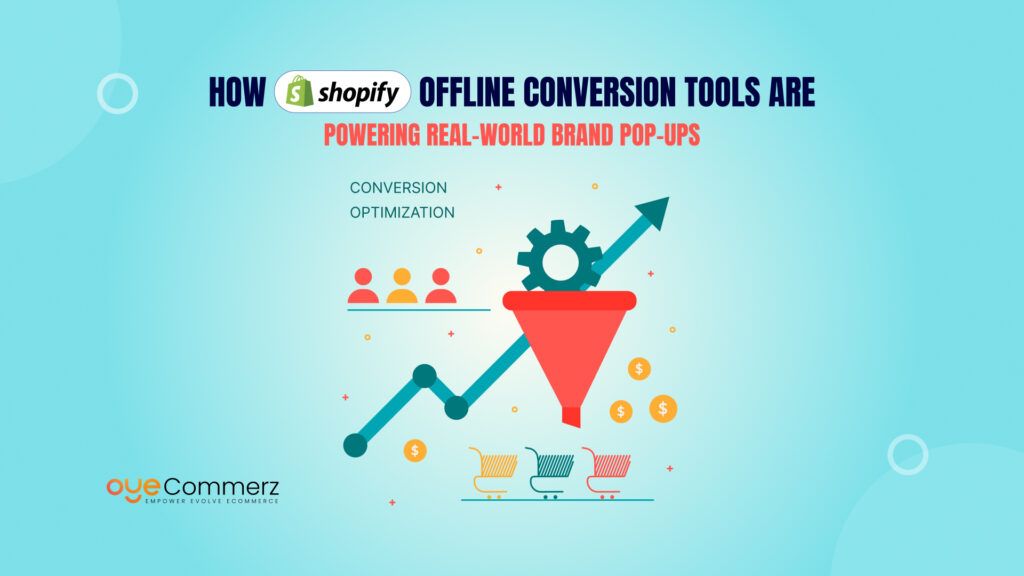Are Magento plugin issues slowing down your business and eating into your valuable time? Studies show that businesses lose up to 20% of their productivity due to downtime and maintenance caused by incompatible plugins.
Managing a business is already challenging and dealing with technical difficulties shouldn’t be part of your daily routine. That’s where Shopify comes in. With its seamless integrations and easy-to-use app store, Shopify lets you focus on growing your business instead of handling plugin issues.
Let’s dive in and explore how Magento Shopify Integration can simplify your operations and make plugin headaches a thing of the past.
Table of Contents
ToggleWhy Integrate Magento with Shopify?
Magento and Shopify are two of the most powerful eCommerce platforms, each offering unique strengths. While Magento is known for its flexibility and customization, Shopify provides ease of use and a streamlined shopping experience. Integrating these platforms allows businesses to leverage the best of both worlds, improving operations and maximizing sales potential.
Common Use Cases for Magento-Shopify Integration
- Expanding to Shopify While Keeping Magento – Businesses that already have a Magento store may want to expand to Shopify to take advantage of its simplicity and fast-growing ecosystem.
- Omnichannel Selling – Companies selling across multiple platforms (Magento for wholesale, Shopify for retail) can sync data for a seamless experience.
- Migrating from Magento to Shopify – Gradual migration by syncing data before fully transitioning to Shopify.
- Marketplace & Multi-Store Management – Running different storefronts for different markets while keeping inventory and order processing centralized.
Challenges of Running Separate Magento and Shopify Stores
Managing two separate platforms without integration can create significant operational challenges:
- Inventory Discrepancies – Stock levels may become inconsistent across platforms, leading to overselling or stockouts.
- Order Management Issues – Handling orders separately increases the risk of delays and errors.
- Customer Data Fragmentation – Inconsistent customer records can impact marketing efforts and personalization.
- Increased Manual Work – Constantly updating product information, prices, and availability across two stores is time-consuming.
How Integration Enhances Sales, Inventory, and Customer Experience
By connecting Magento and Shopify, businesses can streamline their operations and improve customer satisfaction:
- Real-Time Inventory Sync – Prevent overselling by ensuring stock updates instantly across both platforms.
- Unified Order Processing – Process all orders from a single dashboard, reducing delays and improving fulfillment speed.
- Consistent Product & Pricing Information – Maintain uniform product listings and pricing strategies across both platforms.
- Improved Customer Experience – Customers enjoy a seamless shopping journey with accurate inventory, quick order processing, and personalized interactions.
- Automated Workflows – Reduce manual work by syncing customer data, order history, and pricing structures.
What Makes Shopify Different?
1. App Store Simplicity
Shopify’s app store is like a one-stop shop for all your business needs. With thousands of pre-vetted apps, you can easily find tools for marketing, shipping, payments, and more. Most apps are plug-and-play, so you don’t have to worry about complicated installations or customizations.
2. Built for Business Owners, Not Just Developers
Shopify is designed to be easy for anyone to use. Its intuitive dashboard lets you update your store, manage products, and track sales without needing a technical background. This means you can take control without relying heavily on a developer.
3. Reliable Support
Shopify’s support team is available 24/7 to help you solve any issues, whether it’s a question about an app or troubleshooting your store. Beyond this, the platform offers a wealth of resources, tutorials, and a strong community of users and developers to guide you.
4. Automatic Updates and Security
With Shopify, you don’t have to worry about keeping plugins or the platform itself up to date. The system automatically updates itself and its apps, ensuring everything runs smoothly and securely without extra effort on your part.
5. Scalability for Growth
Shopify is built to grow with your business. Whether you’re just starting or managing a large-scale operation, the platform offers flexible features, apps, and plans to match your needs. You can add more tools, handle higher traffic, and expand to new markets without worrying about technical limitations.
These features make Shopify a smart choice for businesses looking for simplicity, reliability, and growth potential.
How Magento to Shopify Integration Solves Your Problems?
Integrating Magento with Shopify can make your business operations more efficient and smooth, without the need to completely abandon your existing systems. Here’s how integrating the two platforms can help solve common problems:

Solving Plugin Compatibility Issues
Magento plugins often have compatibility issues, especially when trying to work with third-party tools. By integrating Shopify with Magento, you can leverage Shopify’s app ecosystem, which is known for being well-tested and compatible with various systems. This ensures smoother integration between the two platforms, minimizing plugin conflicts and improving functionality.
Seamless Data Flow
Integration ensures that your data, including products, orders, and customer information, flows smoothly between Magento and Shopify. This eliminates the need for manual data entry and reduces the risk of errors, ensuring that your business operates efficiently across both platforms.
Streamlined Workflows
Integrating Magento with Shopify allows you to automate and streamline workflows. For example, orders from Magento can be synced with Shopify’s inventory and shipping systems, ensuring that everything runs smoothly without double data entry or confusion. You can manage your online presence more efficiently and provide a consistent experience to your customers across both platforms.
Automatic Updates and Syncing
With an integration in place, you won’t have to worry about manually updating data or content across both systems. Whether it’s product updates, inventory counts, or pricing changes, integration ensures that everything is automatically synced between Magento and Shopify, keeping both platforms aligned and up to date.
Scalability for Future Growth
As your business grows, integrating Shopify with Magento allows you to scale without worrying about compatibility issues. Shopify’s robust infrastructure can handle higher volumes of traffic and transactions, while your Magento system continues to serve as a powerful backend. This integration gives you the flexibility to expand and improve your operations over time.
By integrating Magento with Shopify, you combine the strengths of both platforms, streamline operations, and improve efficiency without the need for a complete migration. It’s a powerful solution for businesses looking to get the best of both worlds.
How to Implement Magento Shopify Integration?
Integrating Magento with Shopify can streamline your business operations, but it’s important to choose the right solution and follow a clear process. Here’s how to make the integration smooth and efficient.
Choosing the Right Integration Solution
When it comes to integrating Magento with Shopify, you have a few options. Let’s break them down:
1. Custom Development
Custom development involves building a unique solution from scratch to connect Magento and Shopify. This option gives you full control over how the integration works but requires technical expertise and may be more expensive. It’s ideal if your business needs specific features that off-the-shelf solutions can’t provide.
2. Third-Party Integration Platforms
There are also ready-made third-party platforms designed to link Magento with Shopify. These platforms, like Oyecommerz, or other integration tools, make it easier to sync data, automate tasks, and manage workflows. They’re faster to implement and usually less expensive than custom development, but may not offer the same level of customization.
3. Pre-Built Shopify Apps
Shopify offers a range of pre-built apps that can integrate with Magento. These apps are designed to handle specific tasks like syncing inventory, orders, or customer data. They are typically easy to install and use, but their functionality may be limited to the features they offer. For businesses that don’t require highly customized solutions, these apps can be a great way to simplify the integration process without the complexity of custom development.
4. Middleware Solutions
Middleware solutions act as a bridge between Magento and Shopify, making data transfers between the two systems smoother and more efficient. These tools provide a more structured approach to integration and are typically used when your business has complex needs but you still want an easier, more standardized solution than custom development. Middleware can be a good option for businesses looking for more control over the integration process without building everything from the ground up.
5. Cloud-Based Integration Tools
Cloud-based integration tools like Celigo or Jitterbit offer a robust and scalable solution for connecting Magento with Shopify. These platforms offer pre-built templates and easy drag-and-drop workflows, allowing businesses to integrate multiple systems without the need for heavy coding. Cloud-based tools are scalable and can grow with your business, but they might require a subscription fee and can sometimes be overkill for small businesses with simpler needs.
Recommendation
For businesses with complex needs that require a fully customized solution, custom development may be the best choice. However, for most businesses, third-party integration platforms and pre-built apps are faster, more cost-effective, and easier to implement. Cloud-based integration tools or middleware solutions can be the perfect middle ground if you need more flexibility without the high cost of custom development.
Key Steps in the Integration Process
Once you’ve selected the right integration solution, here are five key steps to follow for a smooth integration process:

Plan and Map Your Data
Before jumping into the technical details, it’s essential to plan and map out the data that needs to be transferred from Magento to Shopify. This includes:
- Products: Ensure that product names, descriptions, prices, and images are properly mapped.
- Orders: Transfer customer orders, order history, and statuses.
- Customer Information: Migrate customer details, including personal information and order history.
- Inventory Levels: Sync stock levels to prevent overselling or stock discrepancies.
Proper data mapping ensures everything is transferred correctly and helps avoid errors down the road.
Set Up API Connections
Next, configure the APIs (Application Programming Interfaces) that will allow Magento and Shopify to communicate with each other.
- Magento API Configuration: Ensure that Magento’s API settings are set up correctly, allowing access to necessary data like products, customers, and orders.
- Shopify API Setup: Similarly, configure Shopify’s API to allow for data syncing.
- Authentication & Security: Set up secure connections between both platforms to ensure that the data being transferred is safe and protected.
This step is critical for establishing a reliable connection between the two platforms.
Test the Integration
Before going live, it’s essential to thoroughly test the integration to ensure everything works as expected.
- Test Data Sync: Verify that products, orders, and customer details are syncing correctly between Magento and Shopify.
- Test Order Processing: Place test orders to confirm that they are processed correctly and transferred from Magento to Shopify.
- Test Inventory Sync: Ensure that changes in stock levels are reflected on both platforms.
- Test Error Handling: Ensure that error messages are clear and provide insights for troubleshooting.
Testing helps identify and fix issues before the integration goes live, saving you time and resources.
Monitor Data Syncing
Once the integration is live, monitoring the ongoing data syncing is essential for maintaining accuracy.
- Check Sync Frequency: Determine how often data should sync between the two platforms (e.g., real-time, hourly, daily).
- Verify Accuracy: Regularly check that product updates, customer information, and order statuses are syncing correctly.
- Track Errors: Set up error alerts to be notified if something isn’t syncing as expected.
Monitoring ensures that everything continues to work smoothly and that any issues are resolved quickly.
Ongoing Maintenance and Updates
The final step is to perform ongoing maintenance and stay up-to-date with any platform updates.
- Platform Updates: Regularly check for updates from both Shopify and Magento. Ensure that any new updates are compatible with your integration.
- Check for New Features: As both platforms release new features, determine if they should be integrated into your workflow.
- Address New Issues: As your business grows, new integration issues may arise. Stay proactive in fixing bugs and improving performance.
Ongoing maintenance ensures your integration continues to function properly as your business and the platforms evolve.
Get Started Today: Free Consultation for Your Magento to Shopify Integration!
Ready to simplify your eCommerce operations? Take the next step with our consultation or get our Magento Shopify Integration checklist to start the process.
At Oyecommerz, we specialize in seamless Magento to Shopify integrations, ensuring your online business operates smoothly and efficiently. Contact us today to learn how our expert team can help you make the most of your eCommerce platform integration!
Ready to Integrate with Shopify?
Let Us Help You
Conclusion
Integrating Magento with Shopify offers a powerful solution to streamline your eCommerce operations. By connecting these two platforms, you can ensure seamless plugin functionality, reduce compatibility issues, and improve performance across your online store. With Shopify’s user-friendly interface and robust app ecosystem, you’ll have a smoother, more efficient experience while managing your products, orders, and customers.
Whether you’re looking to simplify your processes or enhance your store’s performance, integrating Magento with Shopify can help you achieve your business goals with ease.
FAQs: Magento-Shopify Integration
1. Can Shopify integrate with Magento?
Yes, Shopify can integrate with Magento using third-party tools and APIs. Integration allows businesses to sync inventory, orders, customer data, and pricing across both platforms. Solutions like LitExtension, Zapier, and custom API integrations help automate this process for a seamless experience.
2. Which is better, Magento or Shopify?
It depends on your business needs:
- Magento is best for large, enterprise-level businesses needing full customization and advanced features. However, it requires development expertise.
- Shopify is user-friendly, scalable, and ideal for small to mid-sized businesses looking for a hassle-free eCommerce platform with built-in hosting and support.
3. Why migrate from Magento to Shopify?
Many businesses migrate from Magento to Shopify because:
- Lower maintenance costs – No need for hosting and frequent security patches.
- Easier to use – Shopify is more beginner-friendly with a drag-and-drop interface.
- Faster setup and scalability – Shopify’s cloud-based solution allows quick store setup and automatic updates.
- Better support – 24/7 customer support, unlike Magento’s self-managed model.
4. What is Magento integration?
Magento integration connects Magento with other platforms like Shopify, ERP systems, CRM software, or third-party applications. It enables seamless data transfer, syncing product catalogs, orders, and customer information across multiple systems for better efficiency and automation.





